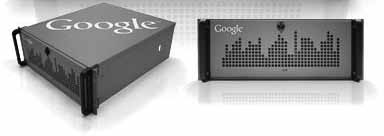Inside Google Radio
by hypo
If you're listening to a radio right now, there's a good chance you're listening to a computer's sound card pushing out audio from an automated program we in the business like to call "automation."
Since the late-1990s, automation systems have been put in all over the country to offer a cost-effective way to provide programming to the audience.
History
Before we get into the guts of the actual system, let's first look into why Google would want acquire radio automation software.
Dave Scott, designer and owner of Texas-based Scott Studios, developed the SS32, an automation system that became widely used around the country. The SS32 offers solid 24/7 performance at a fairly reasonable price.
In the early-2000s, Scott Studios was purchased by dMarc Broadcasting of California. Shortly after the acquisition, dMarc released software called the "dMarc Agent," which would provide real-time diagnostics and information from local stations to a central server. Some of the local information was the title and artist of the song being played on the air. Stations would then use this information and display it on their web site.
Shortly after, dMarc released a version of the "Agent" that also allowed local stations to send their traffic logs, which include items like commercials and public service announcements, to the California server. If there were any holes in the traffic log (filled by non-paying items like PSAs), dMarc would send down audio and schedule it into the local station paid national advertising spots. This was a win for dMarc, who made money on the ad's sale, as well as for the local station, who made money for playing the ad. Is any of this starting to sound familiar?
The inevitable acquisition of dMarc was soon made by Google. Google now calls this program "Audio Ads," a close cousin to it's hugely popular AdSense web-based ad placement system.
The Basics
A basic installation of an SS32 system at a local station relies on having four computers:
- A server-like system called, "Dispatch."
- A system that pre-records jock breaks called "Voice Tracker" or "VT."
- Any computer that sends pre-recorded material like songs, spots, etc (normally called "Production" or "prod").
- And last, but not least, the on-air "SS32" computer.
All of these computers are hooked into a network.
In some installations, all of the computers are connected to the Internet. This may be one of the biggest mistakes a station can make. Some smarter stations create a separate LAN that all of the computers on the audio network are hooked into. Some other office computers, which can run music scheduling software and the "Audio Ads" program as a proxy, have two NICs; one for the audio network and the other to the Internet.
All of the audio ultimately gets sent to the SS32 box via the Dispatch server.
Audio gets ripped into the system by a program called Trim Label & Convert (TLC).
TLC converts the file format, places metadata, and assigns a user-managed cart number into the system. The audio can either be in an MP2 or WAV file format, both of which are proprietary to Scott Studios/dMarc/Google. After TLC does its thing, it sends the audio to Dispatch, which makes a copy of the audio on its local hard drive, then copies the audio to the SS32. Now there are as many as three copies of the audio on the network. This can come in very handy when the SS32 has some type of catastrophic failure. We all know that can never happen, right?
When the SS32 does get hosed, the audio can get fed to a backup SS32 machine.
The backup can run the audio through the network via Dispatch.
Although this is not recommend on a long-term basis, it is good enough to get another "Green Machine" get sent to you from Google. The support that Google offers in amazing. The people who pick up the phone are, for the most part, former users of the SS32 system. This makes the experience on a local level so much easier.
During the day there are many techs on call, in a support center in Texas, while at night there is at least one tech on call, who will call you back in as little as 20 minutes. These folks will stay on the line with you until the problem is fixed. Calls of more than three hours have been logged by yours truly.
If requests to get more in-depth information on Google Radio come in, I will be more than willing to offer it up.
Please note, that Google is now offering a new version (6) of the system which may or not have the components in the network described above.
References
Google Automation Home is here: www.google.com/radioautomation
And Google's "Green Machine" is here: www.google.com/radioautomation/productshardware.html
Is you favorite station running "The Agent"? stations.dmarc.net/Console/NextPlays.aspx?c=WXYZ-FM&tz=EST&n=1&a=TAS
Replace "WXYZ" with your favorite station and replace "FM" with "AM" if need be. You can also plug in your Time Zone (tz). If you want to display any combination of the the Time (T), artist (A), or song title (S) modify the "&a=" argument.
Please keep listening to terrestrial radio.
